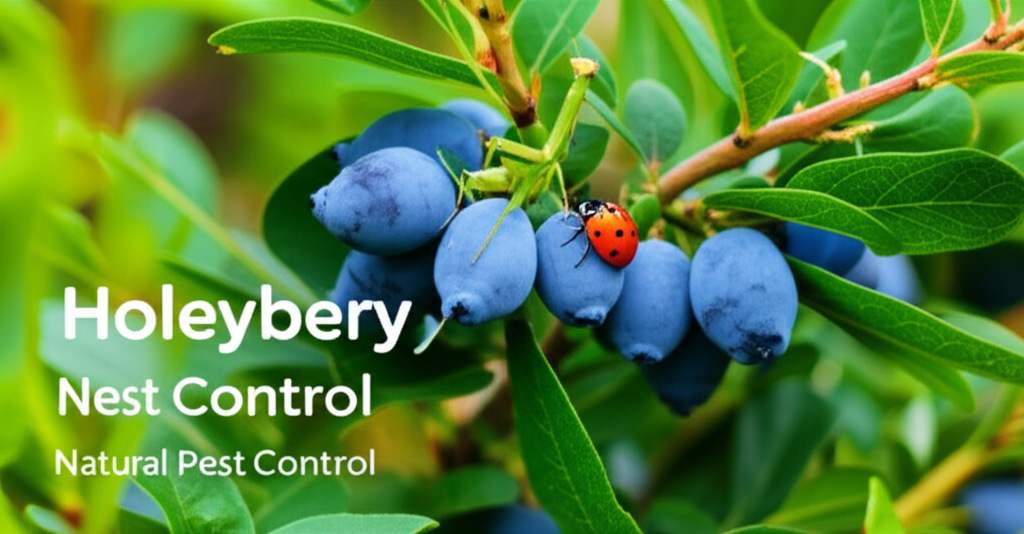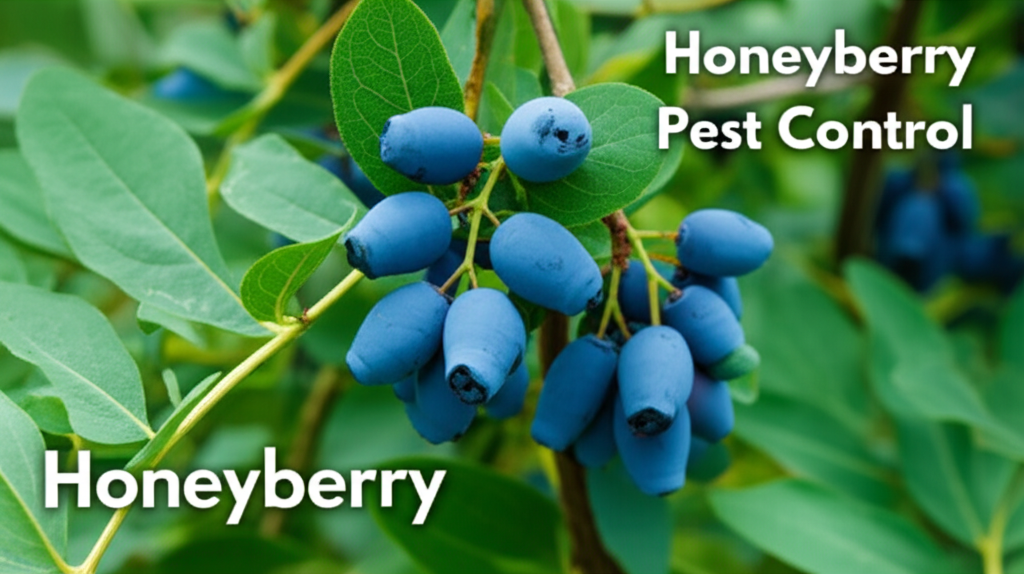Nurturing Your Honeyberry Harvest: Embracing Natural Pest Control
Honeyberry shrubs (also known as Haskap berries) are increasingly popular in home gardens for their delicious, antioxidant-rich fruit and their hardiness. These resilient plants are native to colder climates, making them a fantastic choice for many regions. However, even the toughest plants can face challenges from pests. Fortunately, a proactive and natural approach to pest control can ensure a bountiful and healthy harvest without resorting to harmful chemicals. This guide delves into effective, eco-friendly strategies for keeping your honeyberry shrubs vibrant and productive.
Understanding Honeyberry Pests: Identification is Key

Before you can effectively manage pests, it’s crucial to know what you’re dealing with. While honeyberries are generally robust, a few common culprits might visit your plants. Early detection and identification are paramount for successful natural pest management.
Common Honeyberry Pests
- Aphids: These small, sap-sucking insects often appear in clusters on new growth and the undersides of leaves. They can cause stunted growth and leaf distortion.
- Spider Mites: Tiny arachnids that thrive in dry conditions, spider mites spin fine webs and cause stippling (tiny yellow or white dots) on leaves. Severe infestations can lead to leaf drop.
- Japanese Beetles: These metallic green and coppery-bronze beetles can defoliate plants quickly during their summer feeding frenzy. They are particularly attracted to the flowers and young leaves.
- Leaf Miners: The larvae of certain flies, leaf miners tunnel within the leaves, creating winding, discolored trails. While unsightly, minor infestations usually don’t cause significant damage.
- Slugs and Snails: These slimy gastropods can chew holes in leaves and damage fruit, especially in damp conditions.
Distinguishing Pests from Beneficial Insects
It’s vital to differentiate between pests and beneficial insects that actively help your garden. Ladybugs, lacewings, and hoverflies are natural predators of aphids and other small pests. Observing your plants carefully and understanding the appearance of both beneficial and harmful insects will guide your pest control efforts.
Natural Pest Control Strategies: A Proactive Approach
The cornerstone of natural pest control lies in creating a healthy environment that discourages pests and encourages beneficial insects. This involves a combination of cultural practices, physical deterrents, and biological controls.
Cultural Practices for Prevention
Good gardening practices are your first line of defense.
Healthy Soil and Plant Nutrition
- Composting: Incorporating well-rotted compost into the soil annually improves soil structure, drainage, and nutrient content, leading to stronger, more pest-resistant plants.
- Balanced Fertilization: Over-fertilizing, especially with nitrogen, can lead to lush, tender new growth that is highly attractive to aphids. Use a balanced organic fertilizer appropriate for fruiting shrubs.
- Proper Watering: Consistent, deep watering encourages strong root development. Avoid overwatering, which can create conditions favorable for slugs and snails, and underwatering, which can stress plants and make them more susceptible to spider mites.
Sanitation and Garden Hygiene
- Weed Control: Weeds can harbor pests and diseases. Keep the area around your honeyberry plants free of weeds.
- Debris Removal: Remove fallen leaves and dead plant material, especially at the end of the growing season, as these can be overwintering sites for pests and diseases.
- Crop Rotation (if applicable): While honeyberries are perennial, rotating where you plant them in your garden over many years can help prevent the build-up of soil-borne pests.
Physical Barriers and Deterrents
Sometimes, a simple physical barrier can be highly effective.
Row Covers and Netting
- Floating Row Covers: Lightweight fabric covers can be draped over young plants or during specific pest outbreaks to physically prevent insects like Japanese beetles from reaching the foliage. Ensure they are secured at the base to prevent pests from getting underneath.
- Netting: Fine mesh netting can be used to protect ripening fruit from birds or larger insects.
Manual Removal
- Handpicking: For larger pests like Japanese beetles, the simplest method is to handpick them off the plants and drop them into a bucket of soapy water. It’s best to do this in the early morning when they are less active.
- Water Spray: A strong blast of water from a hose can dislodge aphids and spider mites from the leaves. Repeat as needed.
Beneficial Insect Attraction
Creating a welcoming habitat for natural predators is a cornerstone of organic pest control.
Planting Companion Plants
- Nectar and Pollen Sources: Planting flowering plants that provide nectar and pollen nearby can attract beneficial insects like ladybugs, lacewings, and hoverflies. Good choices include:
Dill
Fennel
Yarrow
Alyssum
Borage
Marigolds
Providing Habitat and Water
- Ground Cover: Allow some clover or other low-growing, flowering ground covers to grow around your honeyberry plants.
- Water Source: A shallow dish of water with pebbles or marbles (to prevent drowning) can provide a crucial water source for beneficial insects, especially during dry spells.
Organic Sprays and Treatments
When preventive measures aren’t enough, organic sprays can provide targeted relief. Always test any spray on a small part of the plant first to ensure it doesn’t cause damage. Apply them in the early morning or late evening when beneficial insects are less active.
Horticultural Oils and Insecticidal Soaps
- Horticultural Oils (Neem Oil, Dormant Oil): These oils smother soft-bodied insects like aphids, spider mites, and scale. Neem oil also has insecticidal and fungicidal properties. Apply according to product instructions, ensuring complete coverage of affected areas. Avoid spraying during hot weather, as it can scorch leaves.
- Insecticidal Soaps: These soaps work by disrupting the cell membranes of soft-bodied insects. They are effective against aphids, spider mites, and whiteflies. Mix a mild liquid soap (like pure castile soap) with water and spray directly onto the pests.
Garlic and Pepper Sprays
- Garlic Spray: A mixture of garlic, water, and a bit of mild soap can act as a repellent for various pests due to its strong odor.
- Pepper Spray (Capsaicin): Blending chili peppers with water and a bit of soap creates a deterrent that many insects dislike. Use with caution, as it can also irritate human skin and eyes.
Diatomaceous Earth (DE)
- How it Works: Food-grade diatomaceous earth is a powder made from fossilized aquatic organisms. Its sharp edges dehydrate and kill crawling insects like slugs and snails that come into contact with it.
- Application: Sprinkle a light layer around the base of your honeyberry plants. It is most effective when dry and needs to be reapplied after rain.
Troubleshooting Specific Honeyberry Pests
Let’s look at how to tackle some of the most common honeyberry pests using natural methods.
Aphid Management
- Early Detection: Inspect new growth regularly.
- Water Blast: A strong jet of water can dislodge them.
- Soapy Water: Spray with insecticidal soap solution.
- Beneficials: Encourage ladybugs and lacewings.
- Neem Oil: Apply as a foliar spray for persistent infestations.
Spider Mite Control
- Increase Humidity: Mites dislike humidity. Mist plants lightly or use a soaker hose around the base.
- Water Spray: Wash them off with a strong water spray.
- Horticultural Oil/Insecticidal Soap: Apply thoroughly to the undersides of leaves.
- Pruning: Remove severely infested branches.
Japanese Beetle Tactics
- Handpicking: The most effective method for home gardeners.
- Barriers: Use row covers during their peak activity.
- Traps: While they can attract beetles, strategic placement away from your plants might help divert them. However, they can also attract more beetles to your general area.
- Encourage Predators: Attract birds to your garden by providing water sources and habitat.
Slug and Snail Solutions
- Manual Removal: Search for them in the early morning or evening, especially after rain.
- Diatomaceous Earth: Create a dry barrier around the plants.
- Beer Traps: Shallow containers filled with beer sunk into the ground are an effective trap. Slugs and snails are attracted to the yeast and drown.
- Copper Tape: Applying copper tape around the base of containers or raised beds can deter them, as copper causes a mild electrical reaction that they avoid.
Key Facts and Comparison of Natural Methods
Here’s a quick overview of popular natural pest control methods for honeyberries.
| Method | Target Pests | Pros | Cons | Application |
|---|---|---|---|---|
| Handpicking | Japanese Beetles, Slugs, Snails | Highly effective, no chemicals, immediate | Labor-intensive, only for visible pests | Direct removal |
| Water Spray | Aphids, Spider Mites | Simple, non-toxic, readily available | Temporary effect, may not kill all | Direct spray on foliage |
| Insecticidal Soap | Aphids, Spider Mites, Whiteflies | Effective against soft-bodied insects, low toxicity | Can cause leaf burn if applied incorrectly, repeat applications may be needed | Foliar spray |
| Neem Oil | Aphids, Mites, Fungi, Larvae | Multi-purpose, natural insecticide and fungicide | Can harm beneficials if not applied carefully, avoid hot weather | Foliar spray |
| Diatomaceous Earth | Slugs, Snails, Crawling Insects | Non-toxic to humans/pets, mechanical action | Ineffective when wet, can harm beneficials if directly sprayed | Applied dry around plants |
| Beneficial Insects | Aphids, Mites, Small Larvae | Sustainable, natural population control | Requires time to establish, may not be effective immediately | Attracted by companion planting, habitat |
Steps to Implement a Natural Pest Control Plan
Creating a robust natural pest control plan involves several key steps, focusing on prevention and timely intervention.
| Step | Action | Timing | Notes |
|---|---|---|---|
| 1 | Assess Your Garden | Spring, Summer, Fall | Regularly inspect honeyberry plants for signs of pests or diseases. Identify specific pests. |
| 2 | Enhance Soil Health | Early Spring, Fall | Amend soil with compost. Ensure proper drainage. |
| 3 | Plant Strategically | Planting Season | Choose a sunny location with good air circulation. Plant companion flowers nearby. |
| 4 | Maintain Garden Hygiene | Ongoing | Weed regularly. Remove fallen leaves and debris. |
| 5 | Implement Physical Barriers | As needed | Use row covers during peak pest seasons or for young plants. |
| 6 | Attract Beneficials | Spring through Fall | Plant a diversity of flowering plants. Provide water. |
| 7 | Monitor and Intervene | As needed | If pests are found, first try manual removal or water spray. Use organic sprays as a second resort. |
| 8 | Seasonal Cleanup | Late Fall | Remove any remaining plant debris to reduce overwintering pests. |
Conclusion: A Sustainable Harvest
Embracing natural pest control for your honeyberry shrubs is not only better for the environment but also leads to healthier, more resilient plants and safer, more delicious fruit. By focusing on creating a balanced ecosystem in your garden, observing your plants closely, and employing a range of preventative and reactive natural methods, you can successfully manage pests and enjoy the sweet rewards of your labor. A little attention and the right approach will ensure your honeyberry bushes thrive for years to come.


